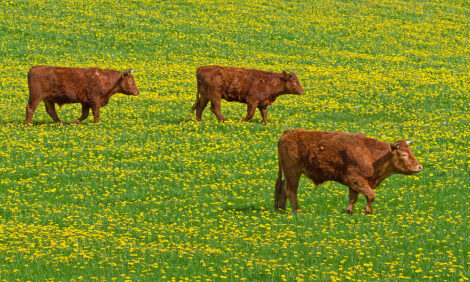



Early Weaning to Cut Costs
US - High fuel and feed costs are pressuring beef producers´ bottom line, but there are options to help relieve the financial pressure, a Kansas State University researcher said."Early weaning is a cost-control strategy that beef producers might consider," said K.C. Olson, who is a cow/calf nutrition specialist with K-State Research and Extension.
Speaking at K-State´s Beef Conference Aug. 7-8 in Manhattan, Olson said that producers may think of early weaning as a last resort. But, a better approach might be to consider the strategy before the situation is dire.
* "Economic damage is almost certain when decision-making is delayed" |
|
K.C. Olson, cow/calf nutrition specialist with K-State Research and Extension.
|
"Economic damage is almost certain when decision-making is delayed," he said. "The decision to wean early, for example, is most often made when the cow is perilously thin and feed costs are out of control."
Early weaned calves are no more prone to health, nutritional, or environmental problems than calves in conventional weaning programs, Olson said. And, there are well-established benefits in terms of calf performance, forage conservation and reduced nutrient requirements for cows.
Weaning calves earlier than usual -- at 30 to 150 days of age, rather than the more typical 240 days -- takes them off of pastures, which both reduces the stocking rate and halts lactation in the cows. In turn, halting lactation earlier trims a cow´s nutritional needs and, therefore, its forage needs earlier.
Because calves are functionally monograstric at birth, some producers may have concerns about whether a calf´s rumen can handle grain consumption early in life. But, studies have indicated that the rumen develops as it needs to, Olson said.
Beyond that, the things to think about when it comes to managing early-weaned calves are the same things a producer should plan for in traditional operations.
Vaccination, parasite control, stress management, disease monitoring and treatment, diet composition and intake management are all important with early-weaned calves -- just as they are for later- weaned animals, the researcher said. Considerations for pen layout, sanitation and animal comfort are still necessary, too.
"All aspects of the nutritional management of early-weaned cattle should be geared toward encouraging dry matter intake," he said, noting that this also is one of the biggest challenges: "Overcoming the reluctance to eat is arguably the most important aspect of weaning management."
Early-weaned calves are even more selective about what they´ll eat than traditionally-weaned calves are. This makes the composition of feed critical to a successful transition, he said. Palatability factors -- moisture content, particle size and ingredients -- are all key to the process.
A clean and abundant water supply is also important.
"Early-weaned calves are small, compared to calves weaned at conventional age," warned Olson, who told conference attendees that he´d seen plenty of cattle-watering devices that were the proper height for 600-pound calves, but not for 400-pound calves.
Because calves are not accustomed to eating from bunks, he suggested that producers place an extra feed bunk and watering device in calf pens, perpendicular to the normal feed bunk. When calves circle the pen, they will encounter the feeding and watering devices.
"Once a few calves encounter and use bunks and waterers, those behaviors will transfer quickly from one individual to another within the pen," he said.
Many producers assume that early-weaned calves are lighter in weight and not as marketable, Olson said. Numerous studies have shown, however, that early-weaned calves fed concentrate diets in confinement have body weights equal to or greater than those of conventionally-weaned animals at the normal weaning time.
"But the real advantage of early weaning is linked to the performance of the cow," he said.
Data from several studies indicate that following earlier calf weaning, cows´ pregnancy rates are higher, the number of days from calving to conception are fewer, and significantly more cows cycle within 85 days of calving. The same research also found body weight at normal weaning time is higher in cows whose calves were weaned early, rather than at the more conventional times.
Olson cited several studies in which cows lost either one body condition score or about 100 pounds of body weight over the course of 60 days. He estimated that producers could save up to $140 per cow during winter 2008 if they prevent this cow body-weight loss by weaning calves 60 days earlier. Even selling a lighter calf immediately after weaning could bring a greater return ($40 to $80) to producer labor and management than waiting for a conventional weaning age.
TheCattleSite News Desk


